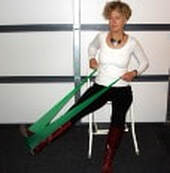|
Conscious activity prevents muscle loss Muscle loss might be an inevitable part of ageing, but exercise can slow the process down. From: Aged Care New Zealand Issue 02 2021  Here’s a sobering fact: one can lose up to 40 percent of muscle mass between your 20s and 80s. That might sound outlandish, but it’s a natural part of ageing. Known as sarcopenia, this is a gradual loss of muscle mass that occurs as we age. Although we can start losing muscles from our 20s, this loss really speeds up once we hit our 60s. At the same time that sarcopenia causes loss of muscle mass, we simultaneously gain fat mass, and see a big drop in strength too. All of this can have a big impact on how well an older person moves. Muscle mass plays a huge role in our health. So much so that sarcopenia and sarcopenic obesity (the combination of low muscle mass and excess fat), and dynapenia (the loss of muscle strength) are associated with a surprisingly wide range of health conditions, from heart disease and diabetes to frailty and dementia. In fact, in people who already have heart disease, those with the highest levels of muscle mass seem to have the best chance of living longer. On the other hand, people with the lowest amounts of muscle seem to be at highest risk of dying prematurely from all causes. This tells us that muscle might play a protective role in heart health. Why this happens, we don’t yet know – but it may have something to do with chemical messengers (myokines) produce by healthy muscles, which can help reduce inflammation throughout the body. Another major benefit of having healthy muscles is that they help protect us from diabetes, which can help reduce inflammation throughout the body. When we eat and digest carbohydrates - such as potatoes, bread or rice – sugar enters our blood stream, a lot of which is sent to our muscles. Our muscles use this sugar for energy or store it as glycogen in order to maintain stable blood sugar levels. This process is an important part of blood sugar control and explains why people with less muscle are more likely to develop diabetes. In older people, low levels of muscle are also linked with a great frailty, weakness, and being less able to carry out normal daily activities. This means people can have trouble with regular tasks such as getting out of bed, standing up from chairs, climbing the stairs or carrying groceries. All of this can make living independently a lot more difficult. Difficulty moving can also mean people end up moving even less which speeds up muscle loss. People with sarcopenia who lead sedentary lives are also at greater risk of osteoporosis. This is because active muscles send signals to bones that help them stay strong. The drop in strength from sarcopenia means people may be more prone to falls and bone fractures. Again, this fear of falling may make some people more sedentary, which may reduce quality of life and put them at a greater risk of depression  Although sarcopenia is a natural part of ageing, muscle loss is largely accelerated by inactivity. As we get older, we tend to move less. But exercise is one of the key signals that our body needs to keep our muscles strong and healthy. Without that signal our muscles start getting smaller and weaker over time. Eating protein also acts as a signal to grow and maintain muscle. However, as we age, we tend to have smaller appetites and eat less protein, increasing the risk of muscle loss. Lower levels of the hormones, testosterone and oestrogen, higher levels of fat, insulin resistance (where the body doesn’t handle glucose as it should, which can lead to diabetes) and higher levels of inflammation are other reasons why older people lose muscle more easily than younger people. In fact, all of these factors combined lead to something called “anabolic resistance”. This means the body doesn’t respond as well to the signals that normally cause muscles to grow. If that isn't enough, current COVID-19 restrictions may be making muscle loss even more likely. Data from smartphones has shown that people have been more sedentary than usual during lockdown. We also know that people’s sleep quality has declined, and people are probably feeling more stress and anxiety. These factors can also speed up muscle loss by affecting hormones that increase muscle breakdown and encourage weight gain by affecting appetite hormones, causing people to eat more processed foods that have more calories. This is called a ‘catabolic crisis’ – a brief period of time when conditions come together to make muscle loss much more likely. Another example of a catabolic crisis would be if someone was hospitalised or forced to spend days, or even weeks in bed. COVID-19 could very well create a catabolic crisis for many adults after lockdown.  Muscle loss can be prevented – or at least slowed – with a few lifestyle changes, namely exercise activity and diet. Resistance exercise, such as lifting light weights or using elastic resistance bands, helps keep muscles strong and healthy and regular walking can help too. High protein diets, containing foods such as lean meats, fish, eggs and low-fat dairy products can also help to build and maintain more muscle than exercise alone. Getting at least 25-40 grams of protein each meal is especially important. On top of that, widely available supplements including Vitamin D, fish oil and creatine (a naturally occurring substance found in the muscles which helps them produce energy) may help people hold on to more muscle and improve their quality of life as they age. During the pandemic, when muscle loss is more likely, prioritising regular exercise and a healthy diet can make a big difference to long-term health. Authors:
Richard Kirwin, PhD Researcher Clinical Nutrition and Physiology, Liverpool John Moores University and Claire Stewart, Professor of Stem Cell Biology, Liverpool John Moores University. From: Aged Care NZ Issue 02 2021 Here at Therapy Professionals Ltd our friendly therapists can assist you to improve your diet and exercise to slow down the loss of your muscle bulk. Just phone: 03 377 5280 or email us at [email protected] Comments are closed.
|
AuthorShonagh O'Hagan Archives
July 2024
|

 RSS Feed
RSS Feed